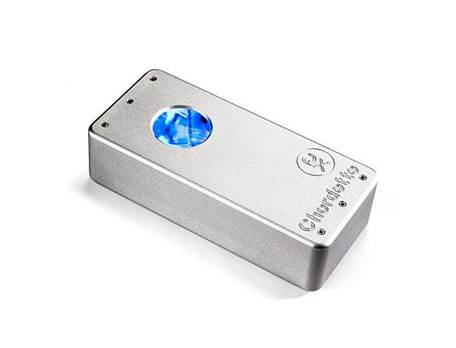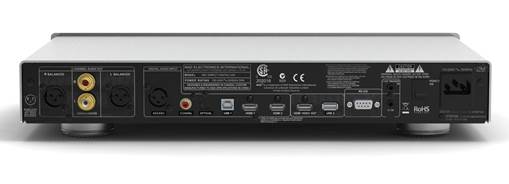Chord Chordette QuteHD: $1,485
Chord does a nice high-end DAC, the QBD76,
but it comes at a price - $6000, to be precise. Mere mortals aren’t going to be
able to stretch that far, but the QuteHD goes a long way to satisfying the
desire for top-drawer sound at the more affordable end of the spectrum.

Resolution
at a glance: The QuteHD’s display changes, color to show signal resolution. Red
signifies 44.1 kHz, yellow 88.2 and blue 192
And, Chrod has gone that extra mile with
the QuteHD. Most manufactures but off-the-shelf conversion solutions form the
likes of Wolfson or Burr-Brown. But Chrod uses an FGPA (Field Programmable Gate
Array) and proprietary software to do the number crunching. This kind of tech
was only previously available on Chrod’s top-of-the-range products, so it’s
great to see it trickle down to a sub-$1500 unit.
And it products spectacular results. It’s a
terrific performer, and if you value qualities such as dynamics and precision
we can’t think of any alternatives we’ve enjoyed more at the money.
The Qute HD’s ability to replay
32-bit/384kHz material is a nice feature to have, but with that kind of content
as rare as hens’ teeth, its ability to handle high-res 24-bit/192kHz files is
of more relevance. It does so through each of its coaxial, optical and USB
inputs. There’s no front panel buttons or display. Inputs are autosensed and
the top window changes color depending on the signal’s resolution.
The Chrodette QuteHD is a truly terrific
product: simple, looks great and above all sounds absolutely fantastic
Crystal-clarity
Whatever input you choose, performance is
impressive (our favorite is the coaxial connection). A 24-bit/96kHz version of
Kate Bush’s 50 Words For Snow proves a joy; the Chrod delivers a full-bodied
and expressive sound, making most rivals sound insubstantial and confused.
Music is rendered with impressive detail and the QuteHD has no trouble
communicating with the listener.

Music
is rendered with impressive detail and the QuteHD has no trouble communicating
with the listener.
The Chrod DAC also manages to nail any
complex rhythms thrown its way. Massive Attack’s Heligoland is riddled with
tricky twists and turns, but they’re no match for this DAC’s grip and agility.
There’s also wide-ranging dynamics to match. Some alternatives, such as the Audiolab
and NAD, sound a little more open but we’re happy to lose that extra airiness
for the Chord’s full-bodied approach.
All in all, this is a terrific product:
It’s simple, looks great and above all sounds absolutely fantastic. Only
jumping up to the next DAC on our awards list will get you something
significantly better and that’s quite a leap in price, too…
Best DAC $1,800+
NAD M51: $2,250
The last time NAD walked away with one of
our Award was 2004. But in 2012 the company is back with a band and one of its
best pieces of hi-fi kit to date. The M51 is the company’s flagship
DAC/pre-amp.

It’s
got HDMI inputs: The M51’s HDMI inputs are for stereo sound only. There’s no on-board
Dolby/DTS surround decoding here.
It’s a serious piece of kit, containing
some high-tech processing that can sample and convert digital music files to a
finer degree than more conventional designs. The result is a breathtaking
display of skill across its array of inputs. These include optical digital, USB
and even a couple of HDMIs, all of which can handle files ranging from
compressed rips to full-fat 24-bit/192kHz high-def tracks. The latter even
allow you to pass through video while the M51 strips off the core audio of a
Blu-ray, so you can enjoy a simple stereo system if surround sound isn’t your
thing.
Spin a CD-standard version of The Battle
from the Gladiator OST and the NAD delivers a masterful performance. It laps up
the low-level dynamics, revealing the finest details and following the rhythmic
build-up, and then bursts into life with the orchestra sounding natural and
well-organized, engaging effortlessly with the listener. The tones and textures
of the various instruments are explicitly revealed by the M51, so you can
directly connect with and feed off the NAD’s energy and enthusiasm. The
minimalist fascia is dominated by a striking Vacuum Fluorescent Display, either
side of which sits power and input selector buttons. All other aspects (such as
the ability to alter volume if you decide to use the M51 as a digital
preamplifier) are controlled by the remote – a weighty, chunky design.

The
minimalist fascia is dominated by a striking Vacuum Fluorescent Display, either
side of which sits power and input selector buttons.
It lap s up low-level dynamics,
revealing the finest details and following the rhythmic build-up…and then
bursts into life
We love the M51 – it’s a class act all
round. If you’ve this kind of money to spend on a DAC, you really can’t do
better.